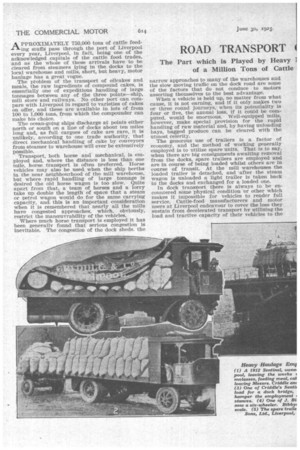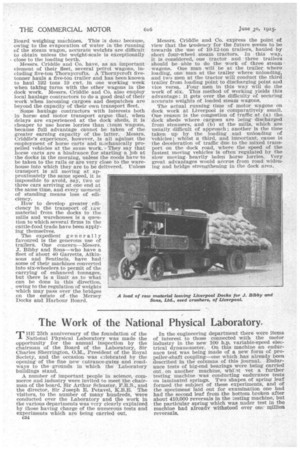ROAD TRANSPORT IIMAL FOODSTUFFS.
Page 16

Page 17

Page 18

If you've noticed an error in this article please click here to report it so we can fix it.
APPROXIMATELY 750,000 tons of cattle feeding stuffs pass through the port of Liverpool every year, Liverpool, in faa, being one of the acknowledged capitals of the cattle food trades, and as the whole of these arrivals have to be cleared from steamers lying in the docks to the local warehouse and mills, short, but heavy, motor haulage has a great vogue.
The problem of the transport of oilcakes and meals, the raw ingredients of compound cakes, is essentially one of expeditious handling of large tonnages between any of the three points—ship, mill store and railways. No other port can compare with Liverpool in regard to varieties of cakes on offer, and these are available in lots of from 100 to 1,000 tons, from which the compounder can make his choice.
The ocean-going ships discharge at points either north or south on a line of docks about ten miles long and, as full cargoes of cake are rare, it is unlikely, according to one trade authority, that direct mechanical handling of cake by conveyors from steamer to warehouse will ever be extensively possible.
Transport, both horse and mechanical, is employed and, where the distance is less than one mile, horse transport is often preferred. Horse vehicles may also be used when the ship berths in the near neighbourhood of the mill warehouse, but where rapid handling of large tonnage is desired the old horse wagon is too slow. Quite apart from that, a team of horses and a lorry take up double the length of space that a steam or petrol wagon would do for the same carrying capacity, and this is an important consideration when it is remembered that nearly all the mills have congested approaches, which, obviously, restrict the manceuvrability of the vehicles.
Where much horse transport is employed it has been generally found that serious congestion is Inevitable. The congestion of the dock sheds. the narrow approaches to many of the warehouses and the slow moving traffic on the dock road are some of the factors that do not conduce to motors asserting themselves to the best advantage. When a vehicle is held up, no matter from what cause, it is not earning, and if it only makes two or three round journeys, when its potentiality is four or five, the annual loss, if it could be computed, would be enormous. Well-equipped mills, however, make special provision for the rapid handling of raw material and, by having unloading bays, bagged produce can be cleared with the utmost celerity. The generous use of trailers is a factor of economy, and the method of working generally employed is to utilize spare units. That is to say, when there are big consignments awaiting removal from the docks, spare trailers are employed and are in course of being loaded whilst others are in course of transit. At the mill warehouses the loaded trailer is detached, and •after the steam wagon is unloaded a light trailer is taken back to the docks and exchanged for a loaded one.
In dock transport there is always to be encountered some physical condition or other which makes it impossible for vehicles to render full service. Cattle-food manufacturers and motor users at Liverpool endeavour to cover the loss they sustain from decelerated transport by utilizing the load and tractive capacity of their vehicles to the utmost. That is why the cattle-food manufacturing firms of Liverpool are now making an increasing use of six-wheelers. The mileage of vehicles employed on the transport of feeding-stuff constituents from the docks to the mills rarely exceeds twenty per day, with three round journeys as a general thing. When the ships are unloaded at a dock in close contiguity to the mills the tonnage performances are obviously better, but everything depends upon the approachability of ship, transit shed or mill warehouse.
Efficiency (expressed as cost per ton) is the aim of all scientific transport users and, in order to examine each form of transport in this relation, it might be worth while to observe the sequence of operations in the handling of the goods, which is as follows :—(1) The goods are discharged by the stevedore and handed to (2) the master porter at the ship's side, who performs the operations of (3) weighing and (4) delivering. The unit on the quay is the gang, consisting of four men. To get efficient and Continuous working it is necessary to have the gang working independently on a particular commodity or commodities and to put on enough haulage to keep it busy all day. In this way a gang may load off 80 tons of rice meal in an eight-hour day. The number of wagons to constitute a haulage unit to keep a gang busy varies with the distance between the two points served. It is not usually con
sidered the best practice to put a definite number of wagons on a job and leave them at it all clay, as this is apt to result in a very considerable waste of time. The practice worked to by Messrs. Griddle and Co., large compound manufacturers, of Liverpool (who with associated companiesoperate a fleet of five six-ten Sentinel steam wagons, two six-ton Yorkshire steam wagons, two live-ton Thornycroft petrol lorries, one Jive-ton Merc6Os and two five-ton Peerless lorries), is to start one wagon on the job at 8 a.m. A second one follows in with a trailer ; a wagon loaded out first thing from the works to the railways will. drop into the quay for a third load, and subsequent vehicles will follow according to the despatch with which loads are rendered available. In this way there is very little light running or waiting about.
Where goods are weighed on the quay by the master porter and then delivered, the steam wagon is the most practical proposition. Messrs. Griddle's first steam wagon--a Sentinel—was acquired in 1912, and a fleet was built up in the course of successive years. The older units are still doing their, work, and compare very favourably with the heavier six-ton wagons, considering that they have been hard at work almost without pause since their purchase.
For a six-ton Sentinel working as described, 170 tons is considered a fair week's work, although as much as 192 tons and over has been moved in that period on several occasions. The average month's working for one wagon would be in the neighbourhood of 700 tons, but some of the six-ton Sentinels have been known individually to handle over, 785 tons in a working month. Taking the five Sentinels working together, a typical monthly tonnage recorded was 3,416 tons. Where parcels of feeding stuffs have to be split up, and goods very often carted from one steamer to another, it is convenient to he able to weigh small parcels on petrol wagons over Mersey Doeks and Harbour Board weighing machines. This is done because, owing to the evaporation of water in the running of the steam wagon, accurate weights are difficult to obtain unless the weight-scale is exceptionally close to the loading berth.
Messrs. Criddle and Co. have, as an important element of their fleet, several petrol wagons, including five-ton Thornycrofts. A Thornycroft fivetonner hauls a five-ton trailer and has been known to haul 192 tons 19 cwt. in one working week when taking turns with the other wagons in the dock work. Messrs. Criddle and Co. also employ local haulage contractors to do a good deal of their work when incoming cargoes and despatches are beyond the capacity of their own transport fleet.
Some haulage contractors with interests both in horse and motor transport argue that, when delays are experienced at the dock sheds, it is cheaper to use horse lorries than uteam wagons, because fun advantage cannot be taken of the greater earning capacity of the latter. Messrs. Criddle's experience, however, is all against the employment of horse carts and mechanically propelled vehicles at the same work. They say that horse carts are a -hindrance for starting a job at the docks in the morning, unless the goods have to be taken to the rails or are very close to the warehouse into which they are to be delivered. Unless transport is all moving at approximately the same speed, it is impossible to avoid, 'Say, two or three cars arriving at one end at the same time, and every moment of standing means loss of efficiency.
How to develop greater efficiency in the transport of law material from the docks to the mills and warehouses is a question to which several firms in the cattle-food trade have been applying themselves.
The expedient generally favoured is the generous use of trailers. One concern—Messrs. J. Bibby and Sons—who have a fleet of about 40 Garretts, Atkinsons and Sentinels, have had some of their machines converted into six-wheelers to permit of the carrying of enhanced tonnages, but there is a limit as to what can be done in this direction, owing to the regulation of weights which may pass over the bridges on the estate of the Mersey Docks and Harbour Board. Messrs. Criddle and Co. express the point of view that the tendency for the future seems to be towards the use of 19-12-ton trailers, hauled by short four-wheel steam tractors. In this way, it is considered, one tractor and three trailers should be able to do the work of three steam wagons. One man will be at the trailer where loading, one man at the trailer where unloading, and two men at the tractor will conduct the third trailer from loading point to discharging point and vice versa. Four men in this way will do the work of six. This method of working yields this advantage : it gets over the difficulty Of securing accurate weights of loaded steam wagons.
The actual running time of motor wagons on dock work at Liverpool is comparatively small. One reason is the congestion of traffic at (a) the dock sheds where cargoes are being discharged from steamers, and (b) at the mills, which are usually difficult of approach ; another is the time taken up by the loading and unloading of vehicles ; whilst a third, and important, cause is the deceleration of traffic due to the mixed transport on the dock road, where the speed of the fastest moving vehicles is often regulated by the slow moving heavily laden horse lorries. Very great advantages would aCcrue from road widening and bridge strengthening in the dock area.






























